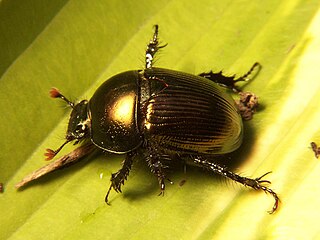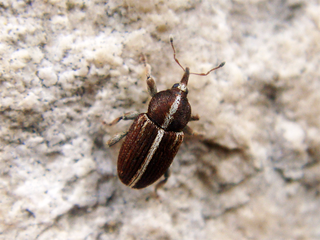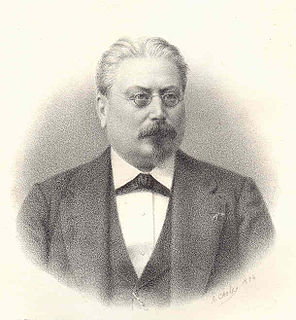Pope Donus was the bishop of Rome from 676 to his death. Few details survive about him or his achievements beyond what is recorded in the Liber Pontificalis.

Achille Valenciennes was a French zoologist.

Baron Charles Athanase Walckenaer was a French civil servant and scientist.

Geotrupidae is a family of beetles in the order Coleoptera. They are commonly called earth-boring dung beetles. Most excavate burrows in which to lay their eggs. They are typically detritivores, provisioning their nests with leaf litter, but are occasionally coprophagous, similar to dung beetles. The eggs are laid in or upon the provision mass and buried, and the developing larvae feed upon the provisions. The burrows of some species can exceed 2 metres in depth.

The beetle subfamily Curculioninae is part of the weevil family Curculionidae. It contains over 23,500 described species in 2,200 genera, and is therefore the largest weevil subfamily. Given that the beetle order (Coleoptera) contains about one-quarter of all known organisms, the Curculioninae represent one of the – if not the – most successful radiations of terrestrial Metazoa.

Geotrupes is a genus of earth-boring scarab beetles in the family Geotrupidae. There are at least 30 described species in Geotrupes.

Jules René Bourguignat was a French malacologist, a scientist who studied mollusks. He served as secretary-general of the Société malacologique de France. He traveled widely, visiting, for example, Lake Tanganyika and North Africa. He reportedly defined 112 new genera and around 2540 new species of mollusks.

Eurypteroidea are an extinct superfamily of eurypterids. It contains three families and two genera of uncertain classification, Paraeurypterus and Pentlandopterus.

Geonemini is a weevil tribe in the subfamily Entiminae.

Geotrupinae is a subfamily of earth-boring scarab beetles in the family Geotrupidae. There are more than 30 genera and 450 described species in Geotrupinae.

Attelabinae is a subfamily of leaf-rolling weevils in the beetle family Attelabidae. There are at least 20 genera and more than 690 described species in Attelabinae.

Stenocerus is a genus of fungus weevils in the beetle family Anthribidae. There are more than 20 described species in Stenocerus.

Ceratophyus is a genus of earth-boring scarab beetles in the family Geotrupidae. There are about 13 described species in Ceratophyus.
Thurandina is a Devonian genus from Alken, Germany. It was initially described by Leif Størmer as a chelicerate arthropod possibly belonging to the order Eurypterida. Nowadays, it is classified as incertae sedis inside Euchelicerata.
Polystomurum is a Devonian genus from Siberia, Russia. It was initially described by Nestor Novojilov in 1958 as a eurypterid with affinities to Marsupipterus inside the family Stylonuridae. Nowadays, it is classified as incertae sedis inside Euchelicerata.

Diederik Jekel is a Dutch science journalist and television presenter.
Hybomorphus is a genus of weevil in the family Curculionidae. There is just one species in the genus, the type species, Hybomorphus melanosomus, the Lord Howe Island ground weevil.
Henri Jekel was a French coleopterist.

Sabalites is an extinct genus of palm. Species belonging to the genus lived in the late Cretaceous to Miocene and have been found in South America, North America, Europe, and Asia. The genus is characterized by its costapalmate leaves, which consist of a radial fan of leaves that have individual pronounced midribs (costa).

Gagatophorus is a genus of weevils belonging to the family Curculionidae, first described by Henri Jekel in 1865. The decisions for synonymy are based on work by Sigmund Schenkling and G.A.K. Marshall (Pseudamycterus), and Elwood Zimmerman.














